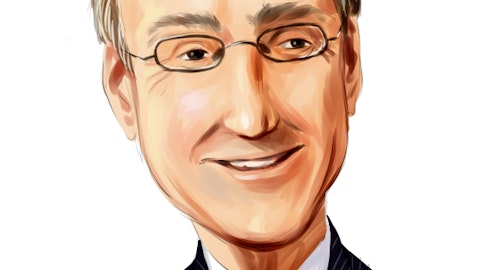And so everything that we’re doing is really about watching where those price gaps are and how we feel about the value proposition. I think what’s been really impressive across our portfolio is that although we’re watching and seeing consumers change behavior in how they’re purchasing and which categories they’re migrating into this has been very, very helpful in the sense of getting the relevancy of our brands continuing to remain quite high. And so I think as we look forward, I’m not seeing anything that would suggest that our pricing would be overly aggressive or necessarily conservative. And I think that’s the way we want to be, and that’s where we want to be balanced. I think you mentioned soup obviously, in places where we’re seeing more private label pressure.
We want to make sure that we’re especially vigilant there in keeping those price gaps reasonable. And I think we’re — right now, we’re exactly where we expected to be on the soup business, actually a little bit better as we continue to see just tremendous momentum on our ready-to-serve side with both Chunky and the introduction of Pacific Can ready-to-serve soup has done very, very well. So probably a little bit ahead there, but on the condensed and broth side, very much in line with our expectations.
Operator: Your next question comes from the line of Peter Galbo from Bank of America. Your line is open.
Peter Galbo: Mark, I was actually kind of hoping to circle back on the guidance a little bit. Are you largely caught up now on the shipment inventory replenishment? Should we kind of expect a shipment relative to consumption to be a lot closer, obviously, versus, I think, the 700 basis point spread that you saw in meals in the first quarter? And then I just have a quick follow-up.
Mark Clouse: Yes. I think we’re pretty caught up. If we think about what we expected, as I said, I think if you remember, we talked a little bit about the unmeasured channels and a little bit of lagging there. I do feel really good. And again, you see that in the 500 basis point delta between our net sales and our consumption that really does reflect some of the — both the inventory recovery in retail, but also those unmeasured channels recovering. And I think as I look forward, I would expect us to be closer and much more in line between consumption and sales as we go forward.
Peter Galbo: Got it. That’s helpful. And then just back on Andrew’s question around the gross margin. I think you said the implied math is that your margins are 20 basis points lower maybe than the flattish from before. A, I just want to make sure that, that was what you said and bet that was a gross margin comment, not an operating margin comment.
Mark Clouse:
?:
Mick Beekhuizen: To your question, when you look at the 20 basis points of reference, that’s really the change versus the previous guidance.
Mark Clouse: Yes, not versus a year ago.
Mick Beekhuizen: Yes, not versus a year ago. So you do see — I mean, as we already described last time around, there was a little bit of that margin pressure year-over-year in the mid-level of our guidance range and you basically have a little bit more of that reflected in the updated guidance.
Mark Clouse: These are significant numbers, but yes, some pressure.
Operator: Your next question comes from the line of Jason English from Goldman Sachs. Your line is open.
Jason English: A couple of quick questions. First, can you remind us how big foodservice is as a percentage of sales in your Meals & Beverages division and give us a little more color on how robust the growth was this quarter?
Mick Beekhuizen: Yes, mid — Jason, I’d say mid-single digits as a percentage of overall net sales for the enterprise.
Mark Clouse: And it was up about 40.
Mick Beekhuizen: 45% or so.
Mark Clouse: Yes, 45%.
Mick Beekhuizen: Significant. And I think if you kind of — right now, in Q1, it was in and around 6% of the overall enterprise.
Mark Clouse: Yes. I think one of the things to keep in mind on that number, Jason, is it was one of the harder hit when we were rationalizing supply a year ago. It was perhaps one of the places that felt that the most significantly. So although I would say we are seeing increase in demand. The biggest driver of that recovery is really the recovery of supply.
Jason English: Got it. That’s helpful. In context of that, you said we should expect consumption sales to be tracking reasonably close. With that type of robust growth, shouldn’t we actually expect your reported results to be outstripping what we see in measured retail sales data going forward?





